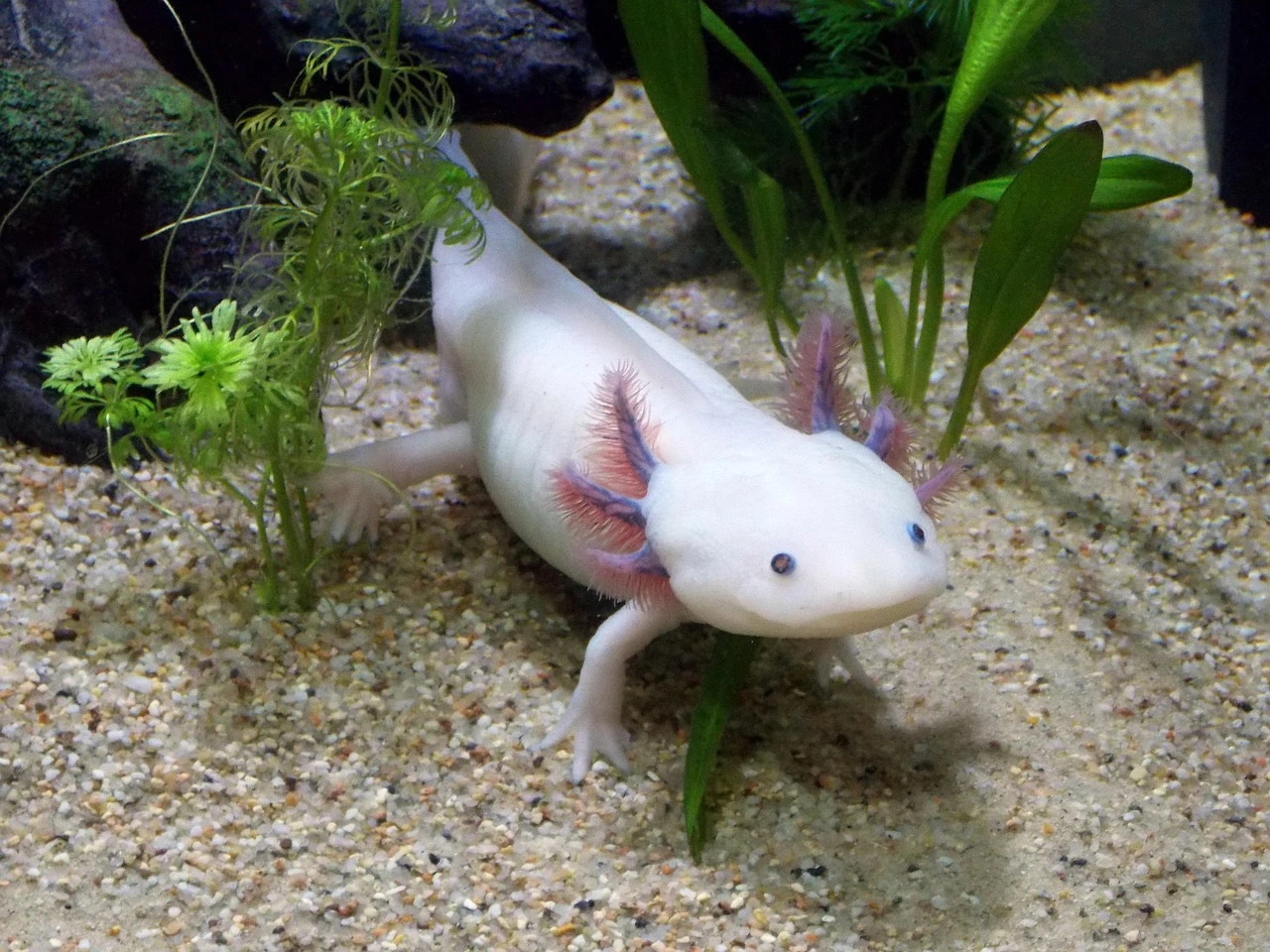Axolotls, also known as Mexican walking fish, are aquatic salamanders that usually stay in water throughout their lives. But some rare cases show that they can morph into land-dwelling creatures, thanks to a gene they share with their close relative, the tiger salamander.
It’s rare, but it happens. My friend Sara Benavides lost her axolotl because of similar reason. So, if your axolotl is losing its gills, sticking its head out of the water, and developing eyelids, it’s not sick. It’s going through metamorphosis, and this process is natural for axolotls with a genetic predisposition.
Importantly, morphing is absolutely not your fault. Even the most experienced keepers can be caught off guard when a pet begins to change, because it’s simply a quirk of nature rather than any care mistake.
Here, I’ll try to explain what morphing, why and how it happens, how to recognize the early signs, and steps to adjust your care if your axolotl is in the process of morphing or has fully morphed.
I’m here to help you feel supported and confident, so that your amazing pet thrives no matter what surprises nature throws its way.
Table of Contents
What Is Morphing? Juvenile vs. Adult Axolotl
Morphing means that an animal changes from an aquatic form to a terrestrial one. Many species undergo metamorphosis, such as a caterpillar transforming into a butterfly, tadpoles developing into frogs, and maggots evolving into flies.
Although morphing is a natural phenomenon, it is not the case with axolotls. Axolotl morphing is quite rare, and it involves the development of lungs, the loss of gills, and the adaptation of limbs to move on land.
The majority of pet stores sell axolotls in the juvenile or larval stage, characterised by external gills on the sides of their heads, tail, and fins, along with a tiny mouth that gives the illusion of a smile.
Under normal conditions, axolotls don’t outgrow their juvenile characteristics. An adult or morphed axolotl has completely different features; they lose their gills, which help them stay alive underwater. Thus, a morphed axolotl needs a special environment to survive.
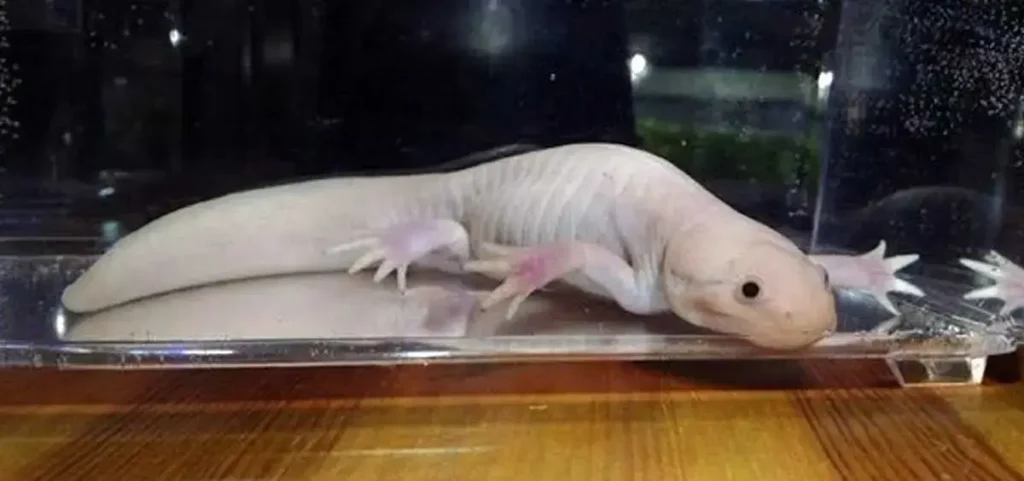
Why Did Your Axolotl Morph?
Most axolotls belong to the Ambystomatidae family of salamanders. They have larval features in their entire lives, even when mature, due to a genetic trait called neoteny. It prevents them from undergoing complete metamorphosis.
Some triggers that induce morphing in axolotls include poor water hygiene, exposure to iodine, and overcrowded water tanks. Moreover, some axolotls may carry genes for morphing, typically due to hybridization with tiger salamanders.
1. Genetics
Local stores may irresponsibly or unintentionally sell hybrid axolotls, which means they are not purebred. This plays a central role in spreading morphing traits across the axolotl population.
Morphing genes likely come from tiger salamander DNA introduced to axolotls in the past to add albino traits.
2. Iodine Exposure
Iodine exposure is a major factor in the morphing process if the axolotl does not possess any morphing genes. Iodine is a crucial element for the production of thyroid hormone thyroxine, which is directly linked to morphing.
The Science Behind Morphing
As said before, axolotls belong to the family of paedomorphic salamanders, which retain their larval characteristics throughout their life, or in fancy terms, you can call it neoteny. Typically, axolotls stay aquatic because their thyroid stops sending growth hormones that trigger metamorphosis. This means they can prevent metamorphosis.
In morphing axolotls, the thyroid doesn’t stop sending these signals, causing them to transform into salamanders. The morphed axolotl typically carries a gene of the Tiger Salamander as a result of interbreeding or hybridization. The purpose of interbreeding is to introduce an albino gene into the axolotl. At the same time, the hybrid ends up acquiring a morphing gene as well.
Morphing in axolotls typically happens between 5-10 months, as the axolotl’s growth slows and transitions out of the larval stage. Morphed axolotls have a shorter lifespan compared to aquatic ones due to the harsh transformation they undergo.
Key Signs of Morphing
It’s easy to spot morphing when you carefully observe your pet. Remember, you must identify a morphed axolotl in a timely manner and provide special care to ensure its survival. You’ll notice the following changes during the process:
- T-Pose: The T-pose is a typical sign in axolotls that indicates their leg bones are changing. Axolotl legs stiffen and stick out as they strengthen to support life on land. They lose the web foot, too.
- Color Changes: There is a chance that axolotl color changes as they morph. Some become lighter in colour while others may appear dark. Spots become clearer and more uniform in the morphed axolotl. Color change is dependent on genes, but a few axolotls may retain their original colour.
- Tucked Gills: Axolotls have external prominent gills on both sides of their head. As they morphed, Gills shrink into gill slits and “tuck” into the sides of the head making them unable to survive in a water tank. However, their lungs expand three times their original size.
- Hooded Eyes: Axolotls have normally flat-looking eyes, which change into bulging eyes. This is a clear indication of a morphed axolotl. Morphed axolotls develop eyelids, giving a sleepy appearance.
- Peeling Slime Coat: The slime coat is essential for surviving in aquatic conditions. With the transition towards the terrestrial environment, the axolotl sheds the slime coat in large sheets in the water tank.
- Disappearing Dorsal: The dorsal and caudal fins vanish during morphing, because they don’t need to swim anymore, leaving a thick tail sometimes with a “zipper” scar. It is the final stage of the morphing process.
- Growing a Tongue: An aquatic axolotl has a broad, flat pad on the bottom of its mouth that does not move freely, but a free-moving tongue develops for catching prey in the terrestrial environment. This is a common sign of a morphing axolotl.
- Blinking: The axolotl can now actively blink with its new eyelids, but aquatic axolotl only show this behavior while swallowing food. The behavior is more common when exposed to a sudden flash of light.
- Throat pulsation: The morphing axolotl exhibits a behavior similar to that of frogs in terms of breathing. While an aquatic axolotl does not possess a diaphragm for respiration, a morphed axolotl prepares itself for land and visibly expands and contracts its throat to get some air.
- Change in Behavior: Some unusual behaviors, such as discomfort in a water tank, loss of appetite, and trouble swimming due to the loss of gills and fins, are observed in axolotls that are undergoing morphing. Many morphed axolotls are observed to be actively digging and start burying themselves in dirt.
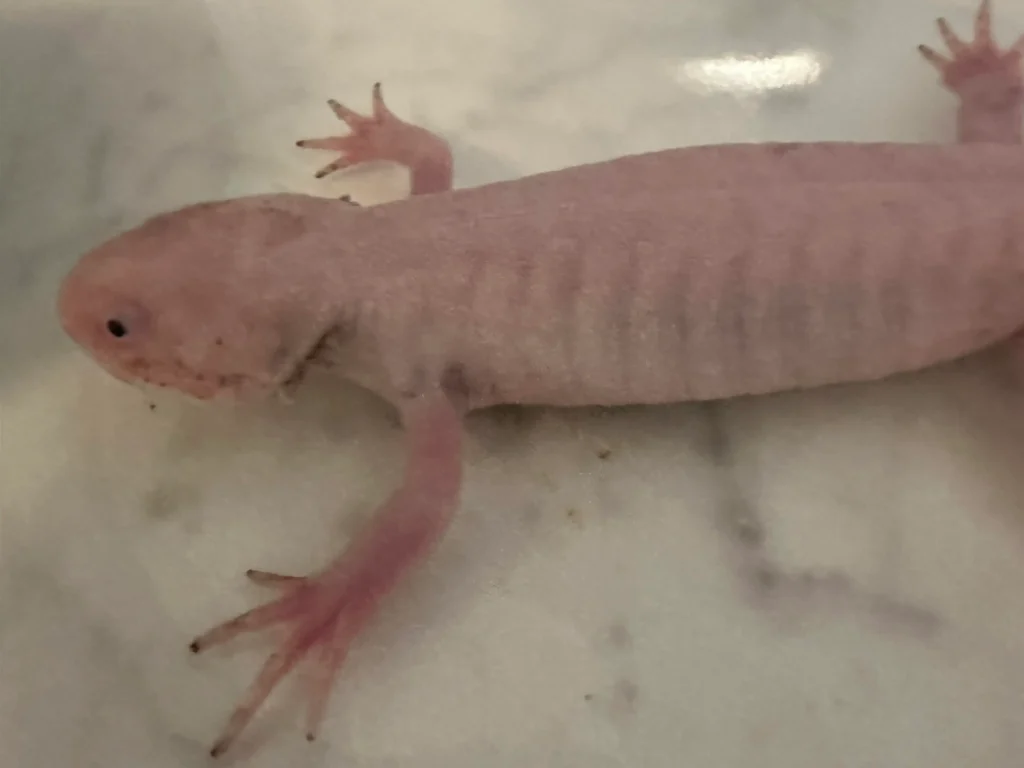
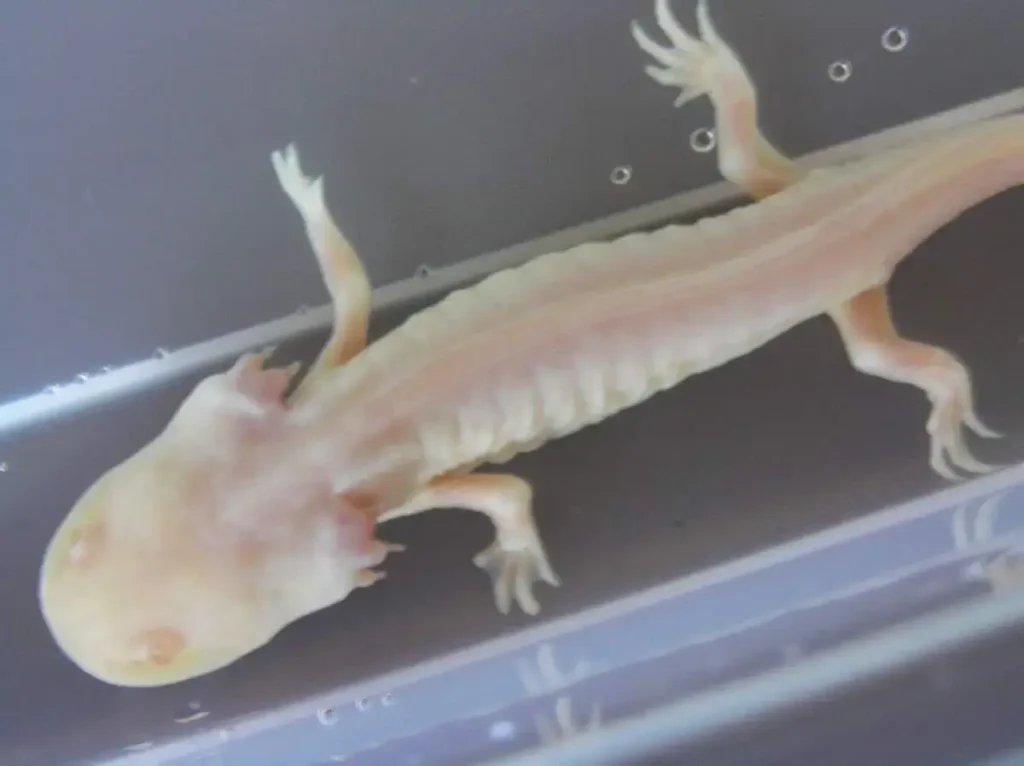
Why Should You Contact the Breeder?
Breeding parents carry a genetic trait that should not be passed on for the following reasons. If you observe signs of axolotl morphing, notify the breeder immediately.
- Buyers expect a fully aquatic pet but end up with a terrestrial salamander, so it’s better to ensure whether the breeder is unknowingly selling the hybrid or is scamming people.
- Morphed axolotls have short life spans, are delicate and stress-prone, and require considerable care. So, it’s not an easy task to raise them. Moreover, the morphing is usually an unexpected event. Many pet owners struggle to find the right care guide for their morphed axolotl. Most morph axolotl dies due to improper care and contradictory information.
- Axolotl has hundreds of babies at a time, which is not affordable for breeders. Buyers may refund or return the pet, and breeders end up with overwhelming numbers of morphed axolotls.
Unethical Breeding Alert
If you find breeders knowingly selling axolotls with morphing genes or hybrids without disclosure, speak up! Let the people know about it to protect buyers and animals. This practice is unethical and harms both the animals and their owners.
The siblings of the morphed axolotl will also undergo morphing within the same week, and they can be anywhere around the city or country. Therefore, it is better to discuss this issue in online communities and expose the breeders involved in this act.
Land Transition of Morphing Axolotl
Now that you are sure your axolotl is undergoing morphing, it is essential to create a safe environment for its transition. The organs of the aquatic axolotl are different from those of the adult axolotl. So, take immediate action, otherwise your morphed axolotl may die in the tank due to drowning. Here’s a simple guide to help you create a safe home for a land-dwelling pet:
Initial Steps
- Temporary Setup: If you notice that the gills and fins are no longer visible or are shrinking, it’s a clear sign that your axolotl is not surviving in the water tank. Keep your morphing axolotl in shallow water in a container or other tank, along with something to climb onto, such as a stone or an upside-down plate.
- Secure the Area: Morphed axolotls can climb. Therefore, use a lid over the container with a few air holes to prevent your axolotl from escaping.
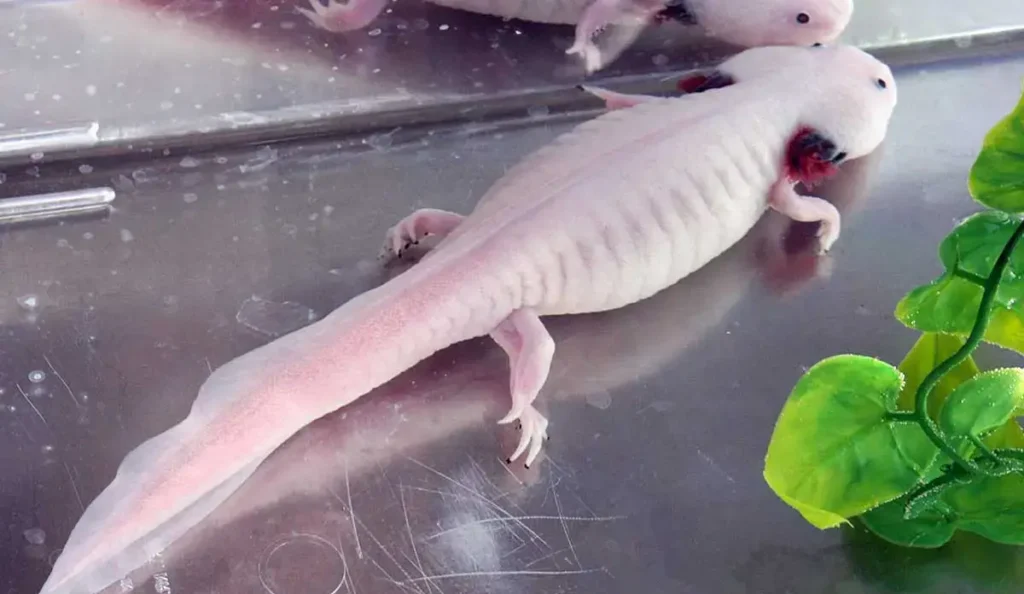
Minimize Handling
The morphed axolotl undergoes very stressful changes, which weaken its immune system. At this stage, the animal is prone to infections and diseases. Therefore, I advise you to keep the environment clean. Handle the axolotl only when necessary, using clean hands (without soap) or, preferably, use gloves.
Transitioning to Land
Some morphed axolotls take longer to completely transition to land, while others make a quicker decision. Never force them out, even if their gills are gone; they’ll move when ready. Remember, it’s an unexpected event for the animal too, so be patient and let it take its time.
All you need to do is:
Add a container with a dampsubstrate (e.g., Eco-Earth, coco fiber) to the water with a ramp for climbing. When the axolotl is ready, it will change its home. Provide some sort of hiding place for the morphed axolotl on the dry part, as it will help them reduce stress and provide comfort. You can buy a hide from any store or make our own by cutting Styrofoam in half.
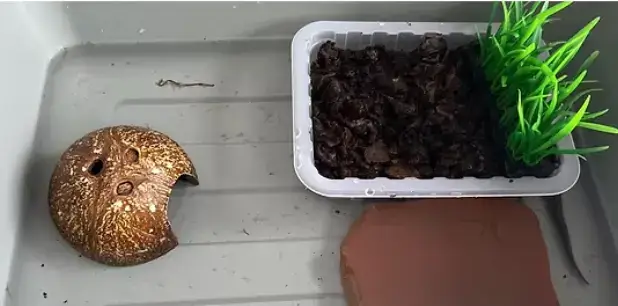
Feeding During Transition
The morphed axolotl’s digestive system is changing. There is a growing tongue and shortening of the intestines. It’s normal for a morphed axolotl to eat less or stop eating temporarily, but continue offering it food during the process.
Give food rich in vitamins and calcium to prevent nutrient deficiency, such as earthworms (cut in half), gut-loaded crickets, dubia roaches, or occasional waxworms for variety.
Be patient with your little salamander if it refuses to eat. Starvation is a common issue among morphed axolotls. However, ensure it is no more than a week. I recommend giving them food they enjoy on regular days.
Otherwise, a tip that works for the majority of morphed axolotl is to place them in a small tub with shallow water. Chop the earthworms into small pieces and spread them around the water. Leave them in the dark or covered. The smell of blood and vibration might trigger feeding.
After Transition
Don’t leave live food in the container and expect the morphed axolotl to eat it, as they are not adapted to hunt prey. Continue bin-feeding or hand-feeding. Some of my food preferences for morphed axolotl are slugs, freshly shed mealworms, waxworms, and earthworms. All of these are rich in fat that will help the animal gain weight, which it lost during the morphing process.
Also Read: How to Care for Your Axolotls
How to Care for a Fully Morphed Axolotl?
Before moving on to the post-care, let me congratulate you for being patient and saving your pet. Many axolotls do not survive the morphing process and die.
For post-care, follow the given steps to help your axolotl safely transition into its new life as a terrestrial salamander.
1. Salamander’s New Home
When the axolotl is completely transformed into a salamander, it needs quite different and unique conditions to survive. Most of the animals love soil digging and hiding in some hives.
- Paludarium Setup
While the majority of morphed axolotl prefer terrestrial environments, some rare animals still want to live in water (NGA-no gill aquatic morph). They may regrow part of their tail fin. Therefore, a paludarium setup is recommended that combines both marine and terrestrial features. This mini ecosystem must have a ¼ aquatic portion.
- Substrate
If you don’t want to go Paludarium style, simply place a shallow water tub or plate in a container. Make it accessible to come out. Moreover, replace the water weekly and use clean, dechlorinated water. For bedding, use a combination of organic topsoil, organic garden soil, and moist sand that is neither too dry nor too wet to the touch.
Avoid using acidic sphagnum moss, peat moss, or coco fiber as a bedding option as it may lower the pH of soil or water, deplete nutrients and calcium from the soil, and harm the delicate skin of salamanders.
- Humidity, Temperature, and Airflow
Provide a drainage layer at the bottom of the habitat and maintain good air flow, as excessive moisture may cause fungal and bacterial diseases. Monitor the humidity and preserve conditions between 60-80% to prevent dehydration and promote skin health.
The temperature range should be between 18 °C and 22°C and must not exceed 25°C for an extended period.
- Hides and Burrows
As axolotls are cousins of Salamanders, they love to hide while sticking their noses out. It provides a sense of security and helps them manage stress. You can decorate the enclosure with stones larger than salamander heads, plants, sanitized wood, and hides (not too many) to mimic their natural habitat.
2. Food Regime
Some axolotls will refuse food for a week. And in this whole process, they might lose some weight. Therefore, it is better to provide them with food rich in fats. Small earthworms, waxworms, and bite-sized crickets are the best choices to help them gain weight. Remove any uneaten crickets from the enclosure to prevent biting, harming, or stressing the salamander.
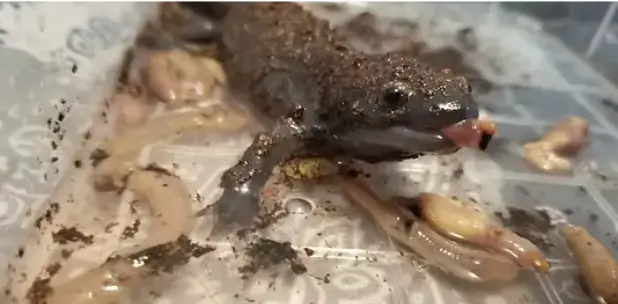
Also Read:
The Axolotl Diaries

A clear, step-by-step handbook (50+ pages) about axolotl care that covers basics, safe tank requirements, cycling, feeding, common health issues, and more.
Rescue-informed and vet-aware. For anyone who wants to raise a healthy, happy axolotl.
Find everything in plain language, backed by real experience.
Grab printable cheatsheets, practical tips, and easy troubleshooting guide inside!
Price: $14.99
FAQs
Can You Stop Or Reverse Morphing Once It Has Started?
The answer to this question can be a yes or a no. If an axolotl has the genetics to morph, nothing can stop it. But to avoid morphing in the future, you must ensure to:
Buy axolotl from reputable breeders who check for morphing history and retire parents with morphing offspring.
As morphing typically happens earlier, I recommend buying an axolotl over a year old to avoid unnecessary issues.
Avoid buying axolotl eggs or babies from online stores, like eBay or unknown pet stores.
Is It Rare For An Axolotl To Morph?
Yes, axolotl morphing is rare. Axolotls are neotenic, meaning that in nature, they retain their larval features throughout their lives. But carrying a morphing gene, environmental factors, and iodine exposure are some contributors to metamorphosis in salamanders.
Is Morphing Spontaneous?
Morphing is unexpected and spontaneous, but the morphing process will take a couple of weeks. During this process, you will notice various symptoms, including bulging eyes, loss of gills and webbed feet, changes in color, and shedding of the slime coat.
Do Axolotls Turn Into Salamanders?
No, not all axolotls turn into salamanders. The process of transformation from aquatic amphibian to terrestrial one is triggered by iodine or thyroxine hormone exposure or when an axolotl has interbred parents that carry Tiger salamander DNA.
How Long Do Axolotls Live?
Axolotl can live 10-15 years in captivity. But this depends on their living conditions and the threats in their habitat. Their ability to regrow limbs helps in increasing their lifespan.
Can Morphing Be Forced?
Yes, scientists can trigger metamorphosis artificially using thyroid hormones for research purposes. However, this must be avoided in typical pet situations because excessive iodine or thyroxine exposure is fatal for axolotls. If your axolotl morphed, it’s due to genetics, not external interference.
Final Thoughts
Axolotl morphing is rare and can catch you off guard. But remember it’s simply a natural quirk, not a sign you’ve done anything wrong.
Try to spot the early signs, tweak their habitat, and adjust their diet, so you can smooth the transition from water to land. Don’t hesitate to lean on experienced breeders or exotic pet veterinarians for extra guidance.
With a bit of preparation and patience, your morphing axolotl will thrive in its new lifestyle!

